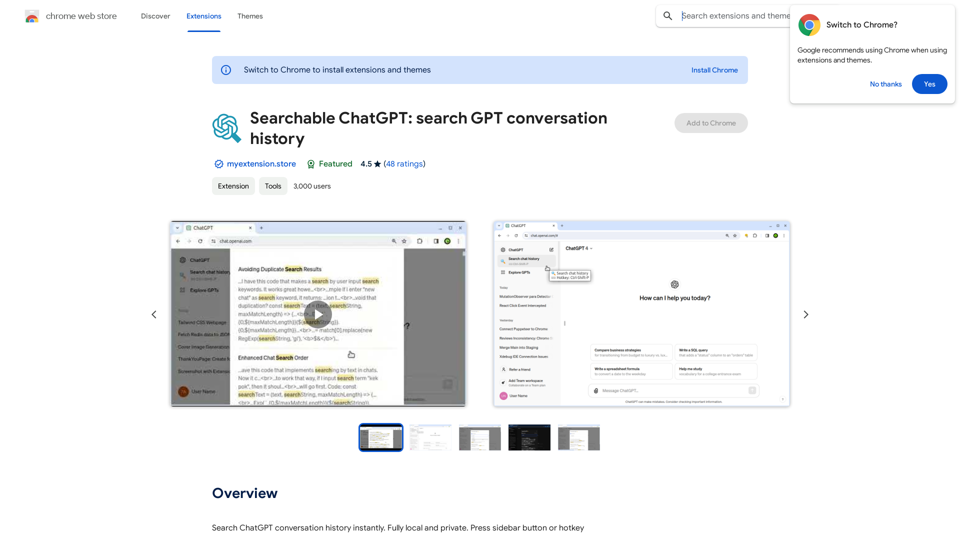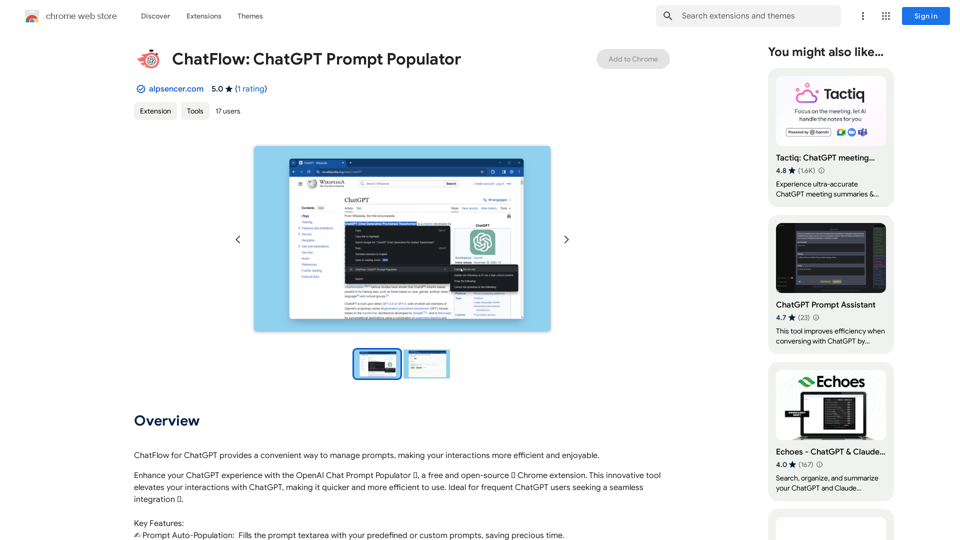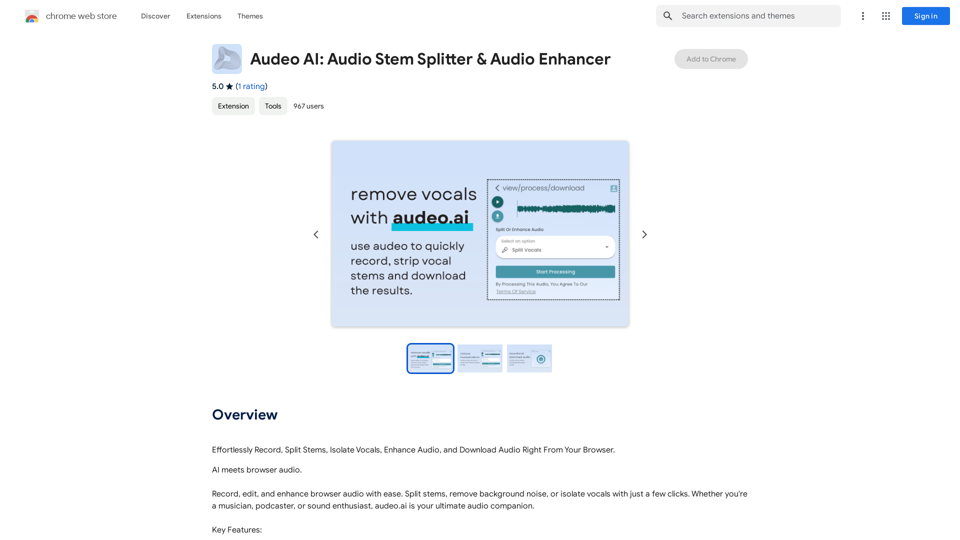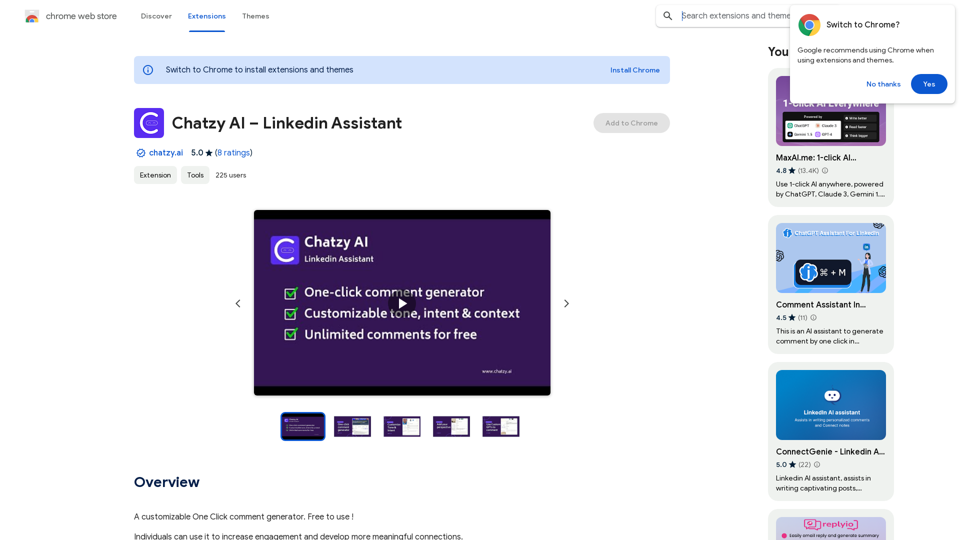Searchable ChatGPT est une extension Chrome conçue pour améliorer l'expérience ChatGPT en offrant une fonctionnalité de recherche instantanée dans l'historique des conversations. Cet outil entièrement local et privé permet aux utilisateurs de retrouver facilement d'anciens chats et messages en effectuant des recherches dans le contenu et les titres des conversations, sans envoyer de données à des API externes.
Recherche de conversations ChatGPT : recherche de l'historique des conversations GPT
Recherchez l'historique des conversations ChatGPT instantanément. Entièrement local et privé. Appuyez sur le bouton de la barre latérale ou la touche de raccourci

Introduction
Fonctionnalité
Puissantes capacités de recherche
- Recherche exacte/floue dans l'historique des conversations ChatGPT
- Suggestions de mots-clés pour faciliter la recherche
- Recherche dans le contenu des messages et les titres des conversations
Confidentialité et sécurité
- Fonctionne localement sans envoyer de données à l'extérieur
- Pas de publicités, de suivi, d'analyses ou de code tiers
Interface conviviale
- Intégration transparente avec l'interface web
- Compatible avec les thèmes clair et sombre
- Raccourci clavier pratique : Ctrl-Shift-P
Indexation locale
- Crée un index local de tous les chats et messages
- Ajoute un bouton de recherche dans la barre latérale
- Utilise l'index local pour trouver les messages correspondants
Fonctionnalités de la version gratuite
- Recherche dans tous les chats et messages
- Limitée à 3 résultats de recherche par requête
FAQ
Comment fonctionne Searchable ChatGPT ?
Searchable ChatGPT crée un index local de tous vos chats et messages. Il ajoute un bouton dans la barre latérale et un raccourci clavier pour ouvrir la recherche. Lorsque vous tapez dans la barre de recherche, il utilise l'index local pour trouver les messages correspondant à votre requête.
Pourquoi Searchable ChatGPT est-il utile ?
Actuellement, ChatGPT n'offre pas de moyen de retrouver d'anciens chats autrement qu'en les faisant défiler. Si vous avez de nombreux chats dans l'interface web de ChatGPT et que vous avez régulièrement besoin de retrouver des sujets précédemment discutés, Searchable ChatGPT est la solution.
Y a-t-il des limitations à la version gratuite ?
La version gratuite de Searchable ChatGPT effectue des recherches dans tous vos chats et messages. La seule limitation est qu'elle n'affiche que 3 résultats de recherche par requête.
Recherche-t-il dans le contenu des chats ?
Oui, il crée un index des noms de chats et des messages. Vous pouvez rechercher n'importe quel mot ou phrase qui a été mentionné dans l'un de vos chats.
Comment puis-je accéder à la fonction de recherche ?
Vous pouvez utiliser le raccourci clavier Ctrl-Shift-P ou le bouton dans la barre latérale pour ouvrir la barre de recherche.
Dernières informations sur le trafic
Visites mensuelles
193.90 M
Taux de rebond
56.27%
Pages par visite
2.71
Temps sur le site(s)
115.91
Classement mondial
-
Classement par pays
-
Visites récentes
Sources de trafic
- Médias sociaux:0.48%
- Références payées:0.55%
- Email:0.15%
- Références:12.81%
- Moteurs de recherche:16.21%
- Direct:69.81%
Sites web connexes

Copilot - Empêcher le défilement vers la page de recherche
Copilot - Empêcher le défilement vers la page de rechercheCette extension empêche les utilisateurs de faire défiler accidentellement vers la page de recherche tout en utilisant Bing AI Copilot.
193.90 M

ChatFlow pour ChatGPT offre un moyen pratique de gérer les invites, rendant vos interactions plus efficaces et agréables.
193.90 M

Extension Chrome alimentée par ChatGPT, améliore l'expérience de navigation et la productivité.
193.90 M

Audeo AI : Séparateur de pistes audio & Améliorant audio
Audeo AI : Séparateur de pistes audio & Améliorant audioEnregistrez facilement, divisez les parties vocales, isolez les voix, améliorez l'audio et téléchargez l'audio directement depuis votre navigateur.
193.90 M

Xmate : Petite amie AI non appropriée pour le travail & Chat porno & Plus
Xmate : Petite amie AI non appropriée pour le travail & Chat porno & PlusFaites vivre vos fantasmes avec le jeu de rôle de personnage AI NSFW. Aucun filtre. Démarrez le sexting AI sans restriction et les bots de chat de sexe AI non censurés et demandez des photos à votre petite amie maintenant.
886


